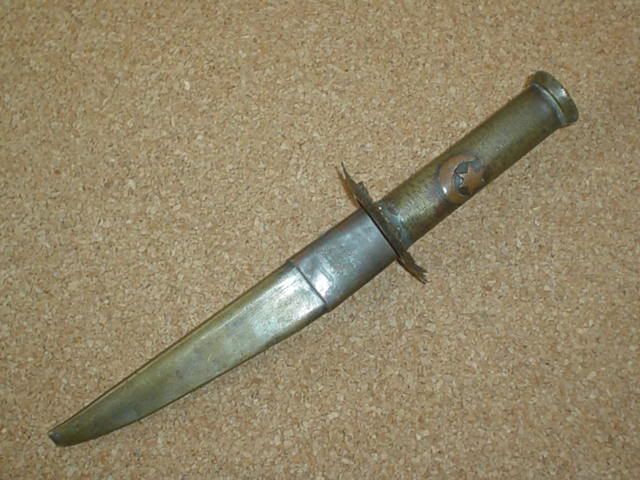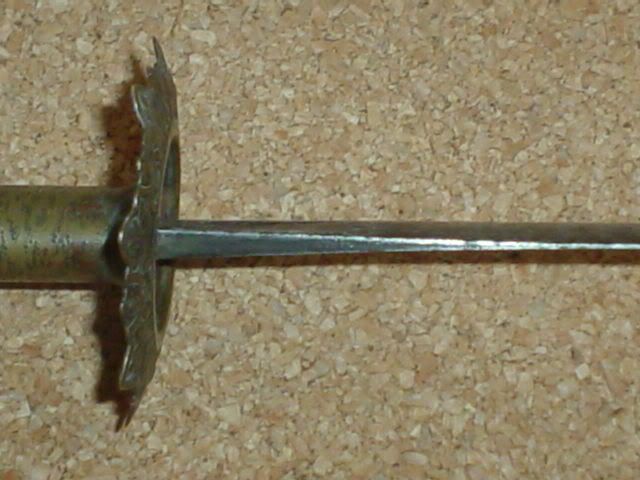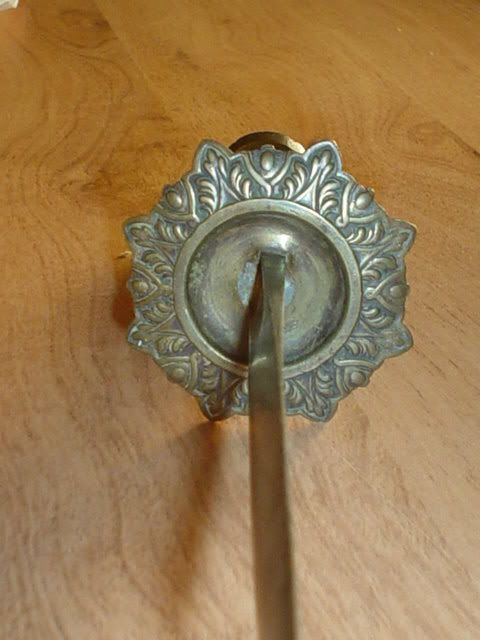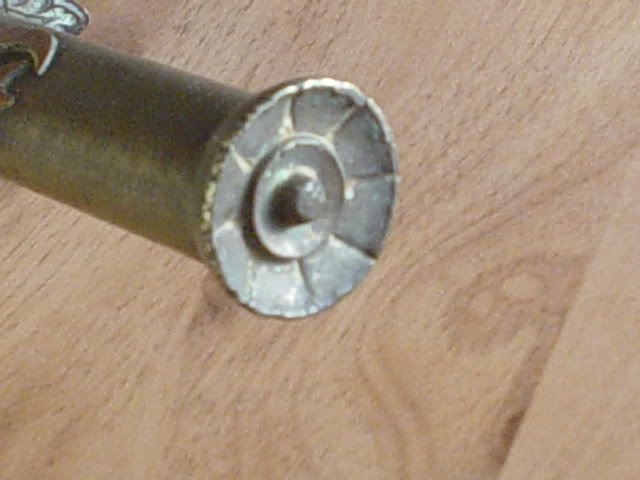
 |
|
|
#1 |
|
Member
Join Date: Dec 2004
Location: Sint-Amandsberg (near Ghent, Belgium)
Posts: 830
|
This probably isn't the place to discuss this dagger, but I would like to show it anyway. I found it on ebay Belgium last week and it was cheap
 I was a bit intrigued with the blade of this knife. It seemed like it was made from some kind of broken sword or bayonet blade. The handle and sheath are made from copper. When I got it I was surprised how well it was made. The seller told me that it was some kind of trench dagger. The knife fits the sheath very well. When you turn it over, it will not fall out of the sheath. The hand guard (or what's it called ?) is also made from copper. On one side of the sheath a ring is attached, probably to fasten the weapon onto a belt. Total length : 28 cm. Look at the pics. Any comment ?   
|
|
|

|
|
|
#2 |
|
Member
Join Date: Dec 2004
Location: What is still UK
Posts: 5,807
|
That certainly looks like a trench knife made from a bayonet. Looks great and I bet you would have to work very hard to get another one. I am not really a reader of WW1 history but I am unaware of Turkish trenches other than Gallipoli/Dardinelles as far as I know the other Ottoman fronts were on open land. A nice buy. Tim
|
|
|

|
|
|
#3 |
|
Member
Join Date: Dec 2004
Location: comfortably at home, USA
Posts: 432
|
I would agree, trench "art". I find the iconography of the cresent and six
pointed star (star of David ???) an interesting juxtaposition, if that's what they are. Rich S |
|
|

|
|
|
#4 | |
|
Member
Join Date: Dec 2004
Location: Bay Area
Posts: 1,622
|
Quote:
Perhaps identifying the bayonet thatw as converted to the knife will provide more clues? I wonder what Erlikhan would have to say about this one, but to me it looks as the tip of a yataghan shaped bayonet, perhaps a Peabody-Martini one? |
|
|
|

|
|
|
#5 |
|
Member
Join Date: Dec 2004
Location: Istanbul
Posts: 452
|
Never have seen something like this. I dont have knowledge about bayonets enough to identify the models of the spare parts, it can be a trench knife but..even if I ignore the Chinese?? looking strange guard (it is circular,not?)which is totally unrelated to Turkish, the existence of 6 pointed star is a real problem. 6 p star has been used in a different form as something magical, but never as a national symbol as far as i know. The flag was 8 pointed in early times, and 5 pointed in the last centuries with nuances in the design. No Turk or any other Moslem around here would think of changing the star with a 6 pointed one when creating a hand made item in 19 or 20th centuries when this item was crafted. Too absurd. I think this item is not long ago created to sell or even if it is old, the crescent -star is mounted to give the item an identity and to increase price later by someone whose history knowledge is not perfect.
|
|
|

|
|
|
#6 |
|
Member
Join Date: Dec 2004
Location: Ann Arbor, MI
Posts: 5,503
|
Erlikhan,
Very astute observation! It looks to me that the blade is a tip of a saber (Bayonets are mostly straight, this blade is curved. Yes, I know some bayos are curved but I am talking probabilities here), while the scabbard and the handle were made out of the original scabbard.There are even traces of soldering on both. The decorations were added as an afterthought. In short, somebody took an old and broken saber and made this dagger. May be trench art, may be bored home-grown Assadullah. The bottom line, this thing can do the job! |
|
|

|
|
|
#7 |
|
Member
Join Date: Dec 2004
Location: Bay Area
Posts: 1,622
|
Sword is possible, but bayonet is not less likely. If you take a close look at the scabbard mouth of this piece, it looks like the brass mouth of a bayonet scabbard: you know, the leather bayonet scabbards with brass mountings. And if the trench art theory is correct, the rest could have been made from a brass shell. The crescent and the star appear inconsistent with the rest of the knife, and I think Erlikhan is right in believing that someone added them later in an attempt to enhance the value of the piece, which is an all too common phenomenon with unknowledgeable traders of militaria. Of course, we will never really know who made this knife and for what purpose, but to me at least it seems well suited to be a trench dagger.
|
|
|

|
|
|
#8 |
|
Member
Join Date: Jun 2005
Posts: 210
|
That scabbard is very odd for a bayonet. Most bayonets scabbards have studs or strap bars by which they are attached to their frogs; but, this thing has a ring, which would lead me to believe that it was intended to be suspended as a sword rather then worn directly on the belt. More likely trench art made from an old sword and a shell casing.
n2s |
|
|

|
|
|
#9 |
|
Member
Join Date: Dec 2004
Location: Sint-Amandsberg (near Ghent, Belgium)
Posts: 830
|
Thanks for all the input, guys
 Erlikhan is right as to the six pointed star. In my hometown, there are many Turkish people and I never noticed that the star on their flag was five pointed. I examined the piece again and yes... the moon and star were added (soldered ?) to the grip. I also looked at some books concerning bayonets and the closest thing I could find which had some resemblance to the point of my knife was the blade of a French 1842 sabre-bayonet. It could also be made from the French 1866 sabre-bayonet 'Chassepot' which had a similar blade.   Here are some additional pictures of my piece :   
|
|
|

|
|
|
#10 |
|
Member
Join Date: Dec 2004
Location: Istanbul
Posts: 452
|
Yes.Only Moroccans have 6 pointed star, but not together with crescent. looks like a yataghan type bayonet edge to me as well. Could be a sharpened and rounded chassepot edge perhaps, or Enfield, German??
The strange hand guard..Perhaps silly but no possibility it was originally the part from a nice bronze lamp, which is always used on the lamp-ceiling joints to conceal the cables and trash??  (I dont know its technical name in English) (I dont know its technical name in English)
|
|
|

|
|
|
#11 |
|
Member
Join Date: Dec 2004
Location: Sint-Amandsberg (near Ghent, Belgium)
Posts: 830
|
Yeah, I know what you mean about the guard. Could perhaps even be part of a candlestick...perhaps older than the rest of the knife

|
|
|

|
|
|
#12 |
|
Member
Join Date: Dec 2004
Location: What is still UK
Posts: 5,807
|
Does anybody know if Moroccan troops fought with the French, like West Africans did in WW1? That might explain Moroccan trench art. The guard looks like it has come from a French object. Tim
|
|
|

|
|
|
#13 | |
|
Member
Join Date: Dec 2004
Posts: 655
|
Quote:
|
|
|
|

|
|
|
#14 |
|
Member
Join Date: Dec 2004
Location: What is still UK
Posts: 5,807
|
I have just read they did and with distinction as all did in that terrible war. Tim
|
|
|

|
|
|
#15 |
|
Member
Join Date: Dec 2004
Location: Istanbul
Posts: 452
|
Well I think a Moroccan can best estimate if it is their trench or not. I dont know if they have ever had use of such a combo design of crescent and star in therir traditions. What I feel from the design, somebody has tried to imitate an Ottoman identity as far as their knowledge and visual memory let them.
|
|
|

|
|
|
#16 |
|
Member
Join Date: Oct 2005
Posts: 44
|
Causcasian front?
Last edited by Andrew; 20th November 2005 at 04:22 AM. Reason: Removed active auction photo |
|
|

|
|
|
#17 |
|
Member
Join Date: Dec 2004
Location: What is still UK
Posts: 5,807
|
Yes I think you might have it, look here,
http://www.militaryhistoryonline.com...offensive.aspx |
|
|

|
|
|
#18 |
|
Member
Join Date: Dec 2004
Location: Sint-Amandsberg (near Ghent, Belgium)
Posts: 830
|
Miyamoto, where did you find this pic ?
|
|
|

|
|
|
#19 |
|
Member
Join Date: Dec 2004
Location: Istanbul
Posts: 452
|
Very interesting! Can u pls show all of the sword? Does it have en suite mountings on scabbard or decoration on blade? I wonder if that is original or a later addition. Rivkin could perhaps have an idea about any possible Caucasian tribe with 6 pointed star ?
|
|
|

|
|
|
#20 |
|
Member
Join Date: Dec 2004
Location: Sint-Amandsberg (near Ghent, Belgium)
Posts: 830
|
I searched on the internet and found some other countries with a star and moon in their flag.
I found an old picture of an Egyptian flag with moon and 7 pointed star. The flag of Azerbedjan shows a moon and an 8 pointed star. Perhaps there's a country (in the Caucasus ?) which uses the symbol of an moon and a 6 pointed star. Who knows ? |
|
|

|
|
|
#21 |
|
Member
Join Date: Dec 2004
Posts: 655
|
Well, not being a specialist:
I've seen quite a lot of shashkas similar to one shown by Miyamoto. In my opinion, they all come from late XIX- early XX century, and may be represent some unknown military pattern (because they all have this 6 point star and crescent). On the other hand the quality of shashkas varies so... Now to the symbolics - while 6 point star was videly used by turkish tribes, its use gradually decreased in favor of 5 and 8 point stars (turks, azeris, karachai, balkar). 6 point star is a symbol of Trabzon weaponry (afaik), but it is always depicted in a circle and without the crescent - as on yataghan's hilt that I attached to the message (btw it belonged to Lermontov. The blade was destroyed due to the soviet restrictions on "weapons".) Now 6 point star, together with crescent and arrows is a symbol of Kabarda tribe (part of circassians). Ironically it is even persisted as part of ensignia of northern caucasus SS unit during WWII. Other adighes prefer to use 5 point stars. 6 point star with a crescent also have been heavily used in Ingushetia. It was also used by "jew-like" muslims in Karachai, and by a very small group of osethian muslisms. Can it be a symbol of circassian units in Turkey ? I think more knowledgeble person has to be asked about it, since the symbol is somewhat too generic to pinpoint the exact origin. I should also point out that six point star and a crescent was used by some of the russian pre-revolution troops from Uzbekistan. |
|
|

|
|
|
#22 |
|
Member
Join Date: Dec 2004
Location: What is still UK
Posts: 5,807
|
I am going to complicate things further by focusing on the design of the guard/lamp bowl. To me it looks western European but objects do get exported and the French taste was and had been the fashion for a few centuries in Russia which in turn must have influenced the countries under the Tzarist regime but saying that the styles of metalwork from either Morocco or the Caucuses as shown on the shashka hilt, are not like the lamp bowl. This might narrow things down to a western front or eastern front and which Islamic troops fought there that would recognise a six pointed star and also most likely to have access to a French? bayonet. Or should I just shut up bearing in mind the yatagan type blade was used extensivly, I do not know. Tim
Last edited by Tim Simmons; 19th November 2005 at 09:01 PM. |
|
|

|
|
|
#23 | |
|
Member
Join Date: Dec 2004
Location: Ann Arbor, MI
Posts: 5,503
|
Quote:
Beware! This item is still active on e-bay and the fiersome Moderators are wide awake. For a similar mistake I have been banned for 10 days. Let's not discuss this shashka for a while. Last edited by Andrew; 20th November 2005 at 04:12 AM. |
|
|
|

|
|
|
#24 |
|
Member
Join Date: Dec 2004
Location: Istanbul
Posts: 452
|
Rivkin, 6 pointed star was always used by Trabzon or any other town in the Ottoman empire and other non Ottomanic Turks or perhaps other Moslems, as a talismanic symbol to bring good luck and fortune and perhaps even didnt decrease till the end of 19th c. The picture you attached is in that manner. 6 pointed star without a crescent. But what would surprize me only is to see it inside a crescent. I have seen crescent and 8 pointed star in Azeri kindjals(and their flag is still 8 p. ), and 5 p. in some others, but not a 6 pointed. So you say, you have seen a lot of shashkas with exactly that design - 6 p. star inside a crescent-, right? By Kabardins. But not other Circassians..Interesting info.
I guess you want to mean Karaims by "Jew like Moslems" .They are Turk in race and language and Jew in religion,whose population were quite large in Ukraine and Caucassia before WW2 German occupation, but very little now. I know them as merchants,and dont think they would have troops, militaristic symbols and productions. Could they have combined 6 p. star and the crescent to symbolize their special identity??And Uzbek troops with the same symbol? I would like to see if any picture is available. regards |
|
|

|
|
|
#25 |
|
EAAF Staff
Join Date: Dec 2004
Location: Louisville, KY
Posts: 7,220
|
IN Rivkin's last picture, the 6 pointed star is called the Star of Solomon by Muslims. Somewhat talismanic.
|
|
|

|
|
|
#26 |
|
Member
Join Date: Dec 2004
Posts: 655
|
Jew-likes is something more similar to turkish denmeh than to karaites - while the latter ones are a sect in judaism. Jew-like (zhukty) means someone who descends from a jew, preferrably on their male line.
The reason for their existance is that until very recently religious identification for most of caucasians was rather vague. People lived by clans, sharing the same male ancestry. Female ancestry did not account for anything (since women were almost in 100% taken from clans or nations different from that of the father). As a result, clans were identified by their founder - chechens of georgian ancestry (gurj), georgians of chechen ancestry, abaza of svan ancestry etc. Similar to this jew-like clans (for example Bagrations) are defined as the ones that were founded by jews. I don't think this sword has much to do with them... Concerning shashkas - unless this is the same shashka being resold over and over again, I've seen quite a lot of those. |
|
|

|
|
|
#27 |
|
Member
Join Date: Dec 2004
Location: Istanbul
Posts: 452
|
Ah got it now. Like Sabetaists (donme) in Turkey. Anyway, if you think the sword has not much to do with them, then let's put point to the ethnical side of the subject as I 've learned continuing ethnical conversations in the forum mean increasing potential of unexpected trouble
 . .
|
|
|

|
|
|
#28 |
|
Member
Join Date: Dec 2004
Location: What is still UK
Posts: 5,807
|
It would be helpful if some buff could come up with a list or map of the trench systems on the various fronts, then find which troops fought there that might use such national emblems. Then we could avoid raking embers. Tim
|
|
|

|
|
|
#29 | |
|
Member
Join Date: Dec 2004
Location: Ann Arbor, MI
Posts: 5,503
|
Quote:
Karaim and Donmeh are two different stories altogether. Karaim are a purely Judaic sect that believes only in the written Torah (Pentateuch) and rejects later books and Rabbinical authorities such as Talmud (G'mara). Their ethnic origin is obscure. Some claim purely Jewish roots and their Turkic language a reflection of the point of their spread from the Crimea where they lived next door to the Tatars. Others suggest their descent from the Khazars (Turkic tribes living north of the Caspian and Black Seas) that converted to Judaism sometimes in the 9-10th century and spread west to Crimea and subsequently to Poland/Lithuania or east to North Caucasus (Tats, Nogais, Karachai etc). In both localities they maintained very militaristic way of life (see Trakai Castle in Lithuania). The Khazar origin is dubious because Karaim were present in medieval Spain in 10-11th centuries. Nevertheless, they were viewed as non-Jews by the Westerners to the point that Russian Tsars were very protective of them and the Nazis did not touch them at all. Donmeh are the descendants of the real Jews: the followers of Sabbetai Zvi, a 17th century Jew who proclaimed himself a Messiah but converted to Islam as soon as the Ottoman Sultan offered him a choice between that and immediate decapitation. Donmeh in Turkey never were militarily oriented and stuck to trade/crafts. By the way, they supported Ataturk and that gave a ground to his enemies to claim that his mother must have been Jewish ("Not Mustafa, not Kemal and not even a Turk"). As Rivkin pointed out, the Royal Georgian Bagratid dynasty (Batonishvilis) claimed descent from a man named Smbat who was allegedly a leader of the Jews brought to the Caucasus (Armenia, mainly) by the Babylonians in 6th century BCE, after the destruction of the First Temple (the original Lost Tribes). True or not is unknown as the equally aristocratic Orbelianis claimed Chinese descent and Abashidzes, Abyssinian. I went into this historical digression simply because it is impossible to understand the history of weapons without knowing the history of men who carried them. Quick example: ancient Kievan Russians carried typically Viking swords but their armour had major "Tatar" influence. Only by knowing that the Vikings were the earliest rulers of the Rus and that Kiev was established by the Khazars (Ki-ev means "place by the water" in Tats language) can we understand this strange and beautiful mix. |
|
|
|

|
|
|
#30 |
|
Member
Join Date: Dec 2004
Location: What is still UK
Posts: 5,807
|
Does this reflect on to the "trench art" knife in question? I have been reading off the net that the eastern front was more open because of the distances involved. I personally think this is a product of Moroccan troops. Tim
|
|
|

|
 |
|
|